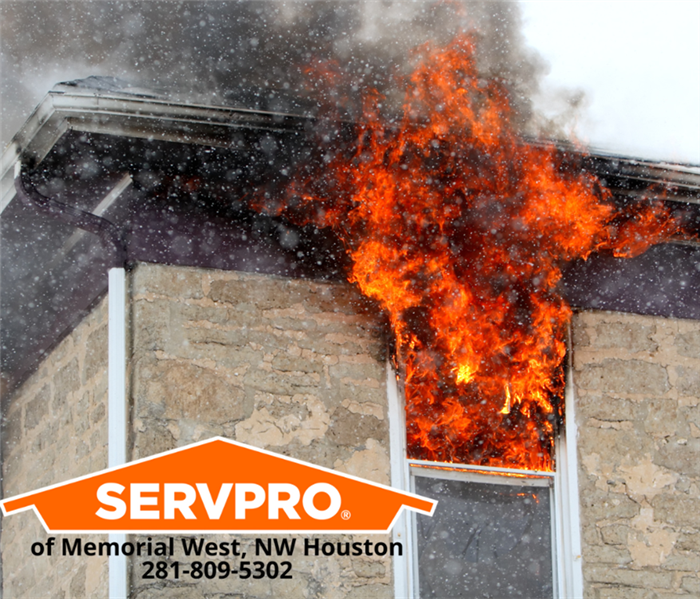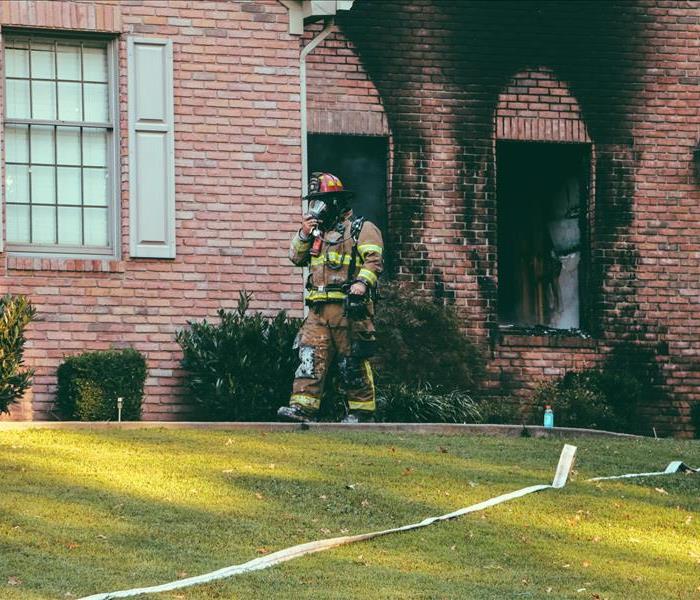Protecting Your Business: Fire Prevention and Emergency Preparedness
4/23/2025 (Permalink)
Fire damage can be devastating for any business. Whether you're managing a retail space, office, or warehouse, implementing a reliable fire protection strategy is essential to reduce risk and limit downtime.
At SERVPRO of Memorial West, NW Houston, we’ve helped countless businesses recover after fire damage. Here are some key tools and tips to help you prevent fires—and how we can support you before and after disaster strikes
Early Warning Systems Save Time and Lives
Installing a commercial fire alarm system is your first line of defense. These systems detect smoke or heat and instantly alert both your staff and local first responders—speeding up response time and potentially saving lives. Early detection often means reduced damage and lower repair costs.
Fire Sprinkler Systems Contain the Flames
Commercial fire sprinkler systems are designed to suppress fire and minimize property damage until firefighters arrive. Did you know?
- Sprinklers typically release about 24 gallons of water per minute
- A standard fire hose releases between 80–120 gallons per minute
While sprinklers may not fully extinguish a fire, they significantly slow its spread—helping to preserve your building and its contents.
Emergency Response Plans Save More Than Just Time
Having a commercial emergency response plan in place is crucial. It outlines critical actions to take before, during, and after a disaster. Your plan should include:
- Emergency shut-off locations
- Vendor contact details
- Insurance provider information
Need help creating one?
SERVPRO of Memorial West, NW Houston offers FREE Emergency Ready Plans (ERPs) for local businesses.
Don’t Forget About Maintenance
Once your fire protection systems are in place, make sure they’re regularly inspected and tested. A malfunctioning alarm or sprinkler system could leave your property vulnerable when it matters most.
If Fire Strikes, Call SERVPRO of Memorial West, NW Houston
Despite your best efforts, fire damage can still happen. That’s where we come in.
SERVPRO of Memorial West, NW Houston is IICRC Certified in Fire and Smoke Restoration. Our team of highly trained technicians responds quickly to clean, restore, and rebuild—so your business gets back up and running fast.
?? Call us today at 281-809-5302 to learn more about our fire damage restoration services or to schedule your free Emergency Ready Plan.
Smoke and Soot Damage in Your Energy Corridor Home or Business: Restoring Your Property After the Fire
5/1/2024 (Permalink)
 Experiencing a house or business fire is already an emotional challenge, turn to the experts that will help you through each step of the process.
Experiencing a house or business fire is already an emotional challenge, turn to the experts that will help you through each step of the process.
Smoke and Soot Damage: Restoring Your Property After a Fire
Fires can wreak havoc on homes, leaving behind a trail of destruction that includes smoke and soot damage. These lingering effects can pose serious challenges for homeowners, but with the right strategies and professional assistance, you can restore your property to its pre-fire condition. In this article, we'll explore the complexities of smoke and soot damage restoration, practical cleaning methods, air purification techniques, and effective odor elimination strategies. As your trusted home restoration partner in the Energy Corridor and surrounding areas, SERVPRO of Memorial West, NW Houston is here to guide you through the process of recovering your property after a fire.
Understanding the Challenges of Smoke and Soot Damage
Smoke and soot damage present unique challenges that require immediate attention. They can infiltrate every corner of your home, causing discoloration, corrosive damage, and persistent odors. Addressing these challenges promptly and comprehensively is crucial for successful restoration.
Practical Cleaning Techniques
- Before commencing the cleaning process, ensure proper ventilation and adhere to safety precautions. Utilize personal protective equipment, such as gloves and masks, to safeguard against harmful particles.
- Begin by dry cleaning surfaces to remove loose soot and smoke residue using methods like vacuuming or dry sponging. Avoid wet cleaning initially to prevent further damage.
- For surfaces that can withstand moisture, utilize specialized cleaning solutions to tackle stubborn soot and smoke stains. Pay close attention to high-touch areas like doorknobs and light switches.
- Professionally clean soft furnishings and fabrics to ensure the thorough removal of soot and smoke particles.
Proper Air Purification
- Deploy air scrubbers equipped with HEPA filters to capture and eliminate airborne particles, including soot and smoke.
- Consider using ozone generators for severe smoke odor, as they can neutralize odors by breaking down odorous molecules.
Proper Odor Removal
- Thoroughly clean and deodorize affected surfaces such as walls, ceilings, and floors to eliminate lingering odors.
- Utilize specialized odor neutralizers to chemically counteract smoke and soot odors effectively.
- In cases of persistent odors, thermal fogging can penetrate hard-to-reach areas to neutralize odors effectively.
Professional Restoration Services
Recognize when professional assistance is necessary for complex smoke and soot damage restoration. An experienced restoration company is imperative. SERVPRO of Memorial West, NW Houston has the expertise and equipment to ensure thorough cleaning, safe air purification, and complete odor elimination. Restoring your property from smoke and soot damage requires attention to detail and the right approach. By implementing proper cleaning techniques, effective air purification methods, and seeking professional restoration services when needed, you can successfully recover your cherished home after a fire. With SERVPRO of Memorial West, NW Houston's expertise and support, you can confidently navigate the restoration process and restore your property to its pre-fire condition.
Fire Damage Restoration Services: How SERVPRO of Memorial West, NW Houston Can Help You Recover
3/22/2024 (Permalink)
 SERVPRO of Memorial West, NW Houston Can Help You With Fire Damage Cleanup and Fire Damage Restoration Services.
SERVPRO of Memorial West, NW Houston Can Help You With Fire Damage Cleanup and Fire Damage Restoration Services.
At SERVPRO of Memorial West, NW Houston we understand the challenges that come with fire damage. We are here to assist you every step of the way. Here's how our expert team can help you recover from fire damage:
Immediate Response: Time is of the essence when it comes to fire damage restoration. Our team is ready to respond swiftly to your call and begin the restoration process immediately. We are avail
Assessment and Inspection: Our trained technicians will conduct a thorough assessment of the fire damage to your home. We'll inspect the extent of the damage and develop a comprehensive restoration plan tailored to your specific needs.
Smoke and Soot Removal: Smoke and soot can spread throughout your home, causing damage and lingering odors. SERVPRO of Memorial West, NW Houston has the expertise and specialized equipment to effectively remove smoke residues and eliminate odors, leaving your home clean and fresh.
Structural Cleaning and Restoration: Fire damage can compromise the structural integrity of your home. Our team will carefully clean and restore structural elements, including walls, ceilings, and floors, to ensure your home is safe and structurally sound.
Content Cleaning and Restoration: Your belongings are precious, and we understand the emotional significance they hold. Our technicians will carefully clean and restore salvageable items, including furniture, clothing, and personal belongings, using advanced cleaning techniques and equipment.
Water Damage Restoration: In many cases, water damage accompanies fire damage due to firefighting efforts. SERVPRO of Memorial West, NW Houston offers comprehensive water damage restoration services to address any water damage issues, including water extraction, drying, and mold remediation.
Odor Removal and Deodorization: Lingering smoke odors can persist long after the fire has been extinguished. Our team utilizes specialized techniques such as thermal fogging and ozone treatment to effectively remove odors and restore indoor air quality.
Reconstruction Services: If your home requires structural repairs or reconstruction after fire damage, SERVPRO of Memorial West, NW Houston has the expertise and resources to handle the job. From minor repairs to complete reconstruction, we'll restore your home to its pre-fire condition.
Insurance Coordination: Dealing with insurance claims can be overwhelming, especially in the aftermath of a fire. Our team will work directly with your insurance company to streamline the claims process.
If your home has been affected by fire damage, don't wait – contact SERVPRO of Memorial West, NW Houston for fast, reliable fire damage restoration services. Our experienced team is Here to Help® you recover and restore your home to its pre-fire condition.




 24/7 Emergency Service
24/7 Emergency Service

